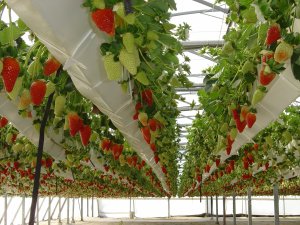Who doesn’t want a fresh garden-picked strawberry in the middle of a cold snowy winter? Hydroponic strawberries are an easy and sustainable method to meet this desire.

Large scale or small, the principles of growing hydroponic strawberries are the same
Strawberries are one of the best plants to grow hydroponically if you want to achieve results that you and your family and friends can enjoy. Hydroponic strawberries are typically large, juicy, sweet, and produced without blemishes. In fact the popularity of hydroponic strawberries is growing, with some pick your own farms now using hydroponics for the cultivation of their strawberry crops.
A few tips and tricks to make sure your hydroponic strawberries are healthy and tasty.
Plant day-neutral varieties: There are several types of strawberry plants available, but day neutral varieties are best for hydroponic production. These plants will produce berries throughout a three to four month growing season. Day neutral strawberry varieties include Everest, Seascape, Tribute, and Tristar.
Stagger planting: Strawberries are perennial plants but that doesn’t mean that they are eternal. Strawberry plants have a three year productive span, with the best production starting in the second Plant new strawberries ever year to ensure continuous production.
Cut the runners: Unless you are using the runners to produce new plants, be sure to clip runners from your strawberry plants as they appear; this new growth will take energy from fruit production. If you keep some runners for future plant production, store them in the refrigerator for several weeks to simulate winter.
Strawberries like it hot: Strawberries will need at least six to seven hours a day of full sun. If growing hydroponic strawberries inside use fluorescent grow lights. Try to the plants in a temperature range from 64 to 77 degrees Fahrenheit.
Pollination is your job: Indoor strawberry plants won’t benefit from natural pollination, so you will need to do the job. As blossoms open, brush their insides with a soft brush or cotton swab to transfer pollen from the stamens to the pistils. An oscillating fan placed near your strawberry plants will help this process as well.
pH and EC are important: the pH of the nutrient solution should be maintained between 5.8 and 6.2 to ensure optimal growth and fruit production. Maintaining a nutrient rich solution at a slightly higher EC (around 2.5) with good levels of potassium with help with sugar accumulation in the fruit.
“Hydro” farm growing hydroponic strawberries
Mastering these tips to grow hydroponic strawberries will ensure large, juicy and sweet strawberries with the added benefit of knowing they are part of a sustainable horticulture system. If you are new to hydroponic gardening start small, read up on the basics before you invest your time or money in a larger system. -KATHY FAIRCHILD